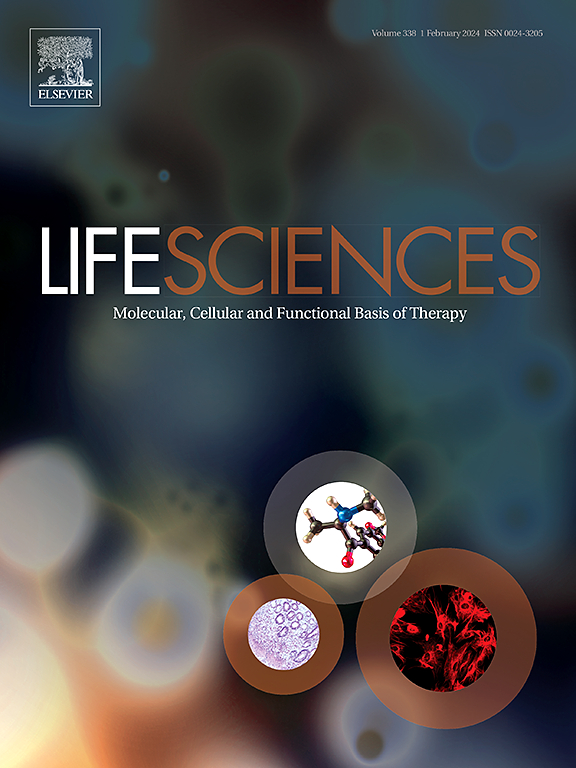罗氟司特通过调节NLRP3/ASC/caspase-1/GSDMD轴减弱阿霉素和环磷酰胺联合诱导的大鼠化学脑。
IF 5.2
2区 医学
Q1 MEDICINE, RESEARCH & EXPERIMENTAL
引用次数: 0
摘要
目的:探讨磷酸二酯酶-4 (PDE-4)抑制剂罗氟米司特对阿霉素(DOX)/环磷酰胺(CP)联合治疗所致认知功能障碍的神经保护作用,并阐明其对焦死通路的调节作用。材料和方法:将大鼠分为5组:对照组、DOX/CP中毒组、DOX/CP加低剂量(0.5 mg/kg/day)或高剂量(1 mg/kg/day)罗氟司特组和单剂量罗氟司特组。进行行为评估和脑组织分析,包括组织病理学染色和炎症和氧化应激标志物的测量。结果:DOX/CP治疗导致认知功能障碍,脑组织异常。显著提高肿瘤坏死因子-α (TNF-α)、白细胞介素-1β (IL-1β)和丙二醛(MDA)水平。同时,超氧化物歧化酶(SOD)活性降低。凋亡相关标志物,包括核苷酸结合寡聚化结构域样受体家族pyrin结构域- 3 (NLRP3)、凋亡相关斑点样蛋白(ASC)、caspase-1、gasdermind (GSDMD)和白细胞介素-18 (IL-18)上调。凋亡标志物caspase-3的表达也增加。相反,连续4周给予罗氟司特(1 mg/kg/天)可改善这些病理改变。罗氟司特改善认知功能,减少氧化应激,调节炎症信号。此外,它还能抑制海马组织内的焦亡和凋亡途径。意义:这些结果提示罗氟司特通过抑制NLRP3/caspase-1/GSDMD焦亡通路对化疗诱导的认知功能障碍和神经退行性变具有神经保护作用。本文章由计算机程序翻译,如有差异,请以英文原文为准。

Roflumilast attenuates doxorubicin and cyclophosphamide combination-induced chemobrain in rats through modulation of NLRP3/ASC/caspase-1/GSDMD axis
Aim
The aim of this study is to investigate the neuroprotective effect of roflumilast, a phosphodiesterase-4 (PDE-4) inhibitor on cognitive impairment induced by doxorubicin (DOX)/cyclophosphamide (CP) combination therapy and to elucidate its modulatory effect on the pyroptosis pathway.
Materials and methods
Rats were allocated into five groups: a control group, a DOX/CP-intoxicated group, two groups receiving DOX/CP plus low-dose (0.5 mg/kg/day) or high-dose (1 mg/kg/day) roflumilast, and a roflumilast-only group. Behavioral assessments and brain tissue analyses were conducted, including histopathological staining and the measurement of inflammatory and oxidative stress markers.
Findings
DOX/CP treatment resulted in cognitive impairment, abnormal brain histology. It significantly elevated the levels of tumor necrosis factor-alpha (TNF-α), interleukin-1 beta (IL-1β), and malondialdehyde (MDA). Concurrently, superoxide dismutase (SOD) activity was reduced. Pyroptosis-associated markers, including nucleotide-binding oligomerization domain-like receptor family pyrin domain-containing 3 (NLRP3), apoptosis-associated speck-like protein (ASC), caspase-1, gasdermin-D (GSDMD), and interleukin-18 (IL-18) were upregulated. Apoptotic marker caspase-3 also exhibited increased expression. Conversely, administration of roflumilast (1 mg/kg/day) for four weeks ameliorated these pathological changes. Roflumilast improved cognitive function, reduced oxidative stress, and modulated inflammatory signaling. Additionally, it suppressed pyroptotic and apoptotic pathways within hippocampal tissue.
Significance
These results suggest that roflumilast exerts neuroprotective effects against chemotherapy-induced cognitive dysfunction and neurodegeneration through inhibition of the NLRP3/ASC/caspase-1/GSDMD pyroptosis pathway.
求助全文
通过发布文献求助,成功后即可免费获取论文全文。
去求助
来源期刊

Life sciences
医学-药学
CiteScore
12.20
自引率
1.60%
发文量
841
审稿时长
6 months
期刊介绍:
Life Sciences is an international journal publishing articles that emphasize the molecular, cellular, and functional basis of therapy. The journal emphasizes the understanding of mechanism that is relevant to all aspects of human disease and translation to patients. All articles are rigorously reviewed.
The Journal favors publication of full-length papers where modern scientific technologies are used to explain molecular, cellular and physiological mechanisms. Articles that merely report observations are rarely accepted. Recommendations from the Declaration of Helsinki or NIH guidelines for care and use of laboratory animals must be adhered to. Articles should be written at a level accessible to readers who are non-specialists in the topic of the article themselves, but who are interested in the research. The Journal welcomes reviews on topics of wide interest to investigators in the life sciences. We particularly encourage submission of brief, focused reviews containing high-quality artwork and require the use of mechanistic summary diagrams.
 求助内容:
求助内容: 应助结果提醒方式:
应助结果提醒方式:


